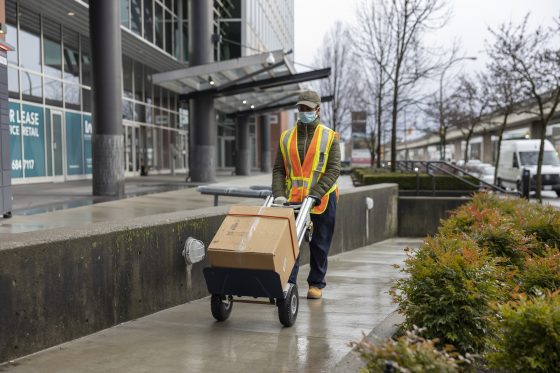A courier dispatcher shares the top hazards delivery drivers face, and gives his take on a new video series about avoiding harm when making routine deliveries.

Photo credit: © WorkSafeBC (Workers’ Compensation Board of B.C.), used with permission
The courier industry, which includes last mile and food delivery services, has grown rapidly since the beginning of the pandemic. With this industry growth, WorkSafeBC claims have increased by 30 percent over three years, primarily due to musculoskeletal injuries (MSIs).
Couriers and delivery drivers often work under intense time pressure, and it’s important that they keep safety top of mind. A friend of mine who works as a dispatcher for a courier company recently told me about the risks that couriers face in their work.
For the sake of anonymity, I’ll call my friend “Phil.” He says that couriers at their company commonly deliver boxes of paperwork and evidence to a courtroom — a time-sensitive task.
“We’re taking boxes from a law firm or a lawyer to a certain courtroom at the courthouse, for a specific time,” Phil says. “These rooms are only available for a small window of time. You can’t just roll in there with a dolly full of boxes while court is in session, so there’s a lot of pressure.”
Sometimes couriers need to retrieve these boxes from storage lockers. Phil says: “There are metal staircases that you have to climb up, then pull out the right boxes that the client wants and bring them down.”
Proper lifting techniques are essential to prevent MSIs, no matter how much of a hurry couriers are in. See WorkSafeBC’s Lifting and handling webpage for information about preventing injuries from lifting and handling.
Usually, a dolly is used to move the boxes — and sometimes there’s a second worker (known as a swamper) on the job.
“I’ve seen some couriers and delivery drivers who wrench their back and end up missing a few days — or even a couple of weeks — of work,” Phil says. “A lot of drivers have chronic back problems, especially the long-term drivers.”
According to WorkSafeBC key statistics, 33% of time-loss claims in courier and local delivery services are overexertion.
The power of paying attention
I told Phil about a new WorkSafeBC video series that promotes a risk management approach for couriers and other delivery drivers. The videos (see below) show some of this industry’s top hazards and how to avoid injury during deliveries. For example, hazards include:
- Wet floors
- Heavy parcels
- Crossing streets
- Objects on sidewalks
Phil says he will show the videos to their drivers — especially the new ones.
“The videos put emphasis on making the right decision beforehand,” he says. “We need to be thinking pre-emptively about what’s going to happen. For example, if I stand directly in front of the elevator door at lunchtime — there could be 20 people stepping out. Or, what’s going to happen if I swing open a door without looking through the windowpane to see if there’s anyone there?”
He adds that paying attention to what’s happening around us is essential — for delivery drivers and everyone else. “It’s human nature to be thinking about something else. Even when we are walking, we need to be aware of our environment — not looking down texting and then walking out in front of a car.”
This advice reminds me of what Jacqueline Morrison told me when I was writing my post, Slow your speed and focus your thoughts in the Cone Zone. Jacqueline, an occupational health and safety consultant at WorkSafeBC, said, “When we say ‘slow down,’ it doesn’t just mean slow down the vehicle. It also means slow down what you’re thinking about and pay attention to the road.”
See WorkSafeBC’s Courier and delivery webpage for more information and resources. Thanks to Phil for talking with me about his work and sharing his thoughts on the new videos.


